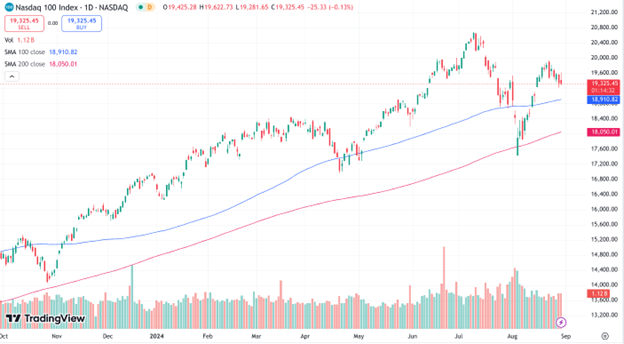The Nasdaq 100, the index representing all-things-tech, has been on a bit of a downward slide (with lots of ups and downs) since July but now seems to be bouncing back.
What happened and what might you need to know in the months ahead?
Too high to fly?
Earlier this year, tech stocks were riding high on a wave of excitement around AI and new tech developments. But by July, investors started to think those prices were just a little too high. So, what did they do? They cashed in their profits, and that sent stock prices, and the entire Nasdaq 100, tumbling.
Not-so-stellar earnings
Some big names in the Nasdaq 100, like Tesla and Google’s parent company Alphabet, had a rough earnings season. Tesla saw its profits drop big time thanks to lower car prices and missed delivery targets, while Alphabet didn’t make as much money from YouTube ads as everyone hoped.
These earnings flops made some investors nervous, and they started selling off tech stocks across the board.
AI growing pains
Everyone loves the idea of AI taking over the world (in a good way), but the reality is that developing all that cool tech is super expensive. Companies like Nvidia and Broadcom, which have been leading the AI charge, saw their stock prices take a hit as investors started worrying about just how much all this AI innovation is going to cost—and whether it’s worth it in the short term.
Plus, Nvidia was virtually priced to perfection, so to speak. So, if a company’s near-term future growth is priced in, there might not be much upside left.
The bigger picture
It’s not just tech earnings dragging down the Nasdaq 100. The Federal Reserve has been hinting at future interest rate cuts, which usually sounds like good news. But many investors are worried about how effective these cuts will be if the economy slows down.
All that uncertainty has made the Nasdaq 100 index even more volatile.
Shifting gears (sector rotation)
Lately, many investors have been moving their money from big tech stocks to smaller, value-driven companies. They’re betting that these smaller companies will do better if the economy grows, leaving the tech-heavy Nasdaq 100 in the dust.
That’s why you may be seeing other indices like the Russell 2000 doing better while the Nasdaq 100 struggles.
The Technical Outlook

Trend Watch: For the uptrend to continue, the NDX must stay above the August swing low of 17250 and eventually break above the yearly high of 20750. If the Nasdaq continues to fall, expect potential support at the 100-day and 200-day moving averages.
The Takeaway
Tech stocks have been the golden child of the market, but now they’re getting a reality check. Between overvaluation, lackluster earnings, AI expenses, and some serious macroeconomic uncertainty, the Nasdaq 100 may be in for a bumpy ride.
Please be aware that the content of this blog is based upon the opinions and research of GFF Brokers and its staff and should not be treated as trade recommendations. There is a substantial risk of loss in trading futures, options and forex. Past performance is not necessarily indicative of future results.
Disclaimer Regarding Hypothetical Performance Results: HYPOTHETICAL PERFORMANCE RESULTS HAVE MANY INHERENT LIMITATIONS, SOME OF WHICH ARE DESCRIBED BELOW. NO REPRESENTATION IS BEING MADE THAT ANY ACCOUNT WILL OR IS LIKELY TO ACHIEVE PROFITS OR LOSSES SIMILAR TO THOSE SHOWN. IN FACT, THERE ARE FREQUENTLY SHARP DIFFERENCES BETWEEN HYPOTHETICAL PERFORMANCE RESULTS AND THE ACTUAL RESULTS SUBSEQUENTLY ACHIEVED BY ANY PARTICULAR TRADING PROGRAM.
ONE OF THE LIMITATIONS OF HYPOTHETICAL PERFORMANCE RESULTS IS THAT THEY ARE GENERALLY PREPARED WITH THE BENEFIT OF HINDSIGHT. IN ADDITION, HYPOTHETICAL TRADING DOES NOT INVOLVE FINANCIAL RISK, AND NO HYPOTHETICAL TRADING RECORD CAN COMPLETELY ACCOUNT FOR THE IMPACT OF FINANCIAL RISK IN ACTUAL TRADING. FOR EXAMPLE, THE ABILITY TO WITHSTAND LOSSES OR TO ADHERE TO A PARTICULAR TRADING PROGRAM IN SPITE OF TRADING LOSSES ARE MATERIAL POINTS WHICH CAN ALSO ADVERSELY AFFECT ACTUAL TRADING RESULTS. THERE ARE NUMEROUS OTHER FACTORS RELATED TO THE MARKETS IN GENERAL OR TO THE IMPLEMENTATION OF ANY SPECIFIC TRADING PROGRAM WHICH CANNOT BE FULLY ACCOUNTED FOR IN THE PREPARATION OF HYPOTHETICAL PERFORMANCE RESULTS AND ALL OF WHICH CAN ADVERSELY AFFECT ACTUAL TRADING RESULTS.